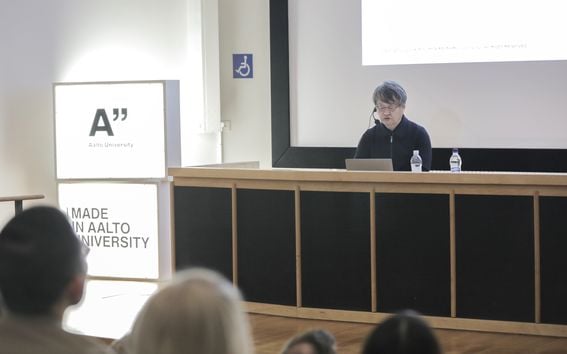An interview with designer Naoto Fukasawa

How is MUJI different from other companies?
First, for us, it is important to think about the users, and always start by asking what is wrong and what is right, and what is needed.
Our starting point is to think about better futures. The focus of design is not on things, but on atmosphereat at first. Micro-considerations of ambience and details lead to the integrity of things. We always try to simplify and design amazing small details.
For me, designing seems like sculpturing. I try to find typologies, the shape that expresses. The form should be following human behaviour. Material is so important. What is the honest true material for each object? A designer should eliminate the sense of discomfort, and think about the outline of surrounding mediums.
How do you perceive Finnish Design?
My personal impression is that Finnish design is still craft, not just industrial products. Even in very high technology products, the craft mindset still exists in this country. I feel that Finns do not distinguish between modern product and all hand-made product.
Even when you are one of the smartest countries in the world, Finns continuously ask what is a happy life and what is the quality of life. You are smart, because you can to stop and think about what is right and what is wrong, and that is important.
All the world is non-stop thinking about making their own platforms larger. But you Finns think about the size of human life, and it can be enough. You always think about what is happiness, what is important, and what is suitable. The chairman of MUJI was very touched about Finnish mentality and the attitude of thinking what is important for the future of human life.
You teach at Tama Art University. What aspects do you consider being important in Design education?
Design was integrated. Architect Alvar Aalto designed also glass and chairs. He had no limitations to designing the tools that are integrated into our life. At some point, particularly in design education design was divided into different categories like graphic design, product design, interior design, architecture, and so on.
But in our life, we wear clothes, we see signs and graphics and we use products. Our life is already integrated. Why do designers need to make the decision to choose what to do particularly, to me that is very strange. Particularly, when in our current life is all mixed together. That is why at Tama University we have a program called “Integrated design” that breaks down the conventional segmentation of fields.
What advice would you give to a design student today?
Once you have completed an object and feel that it is really good, it is not ready yet. Then you need to step back and rethink once more. The functionally complete object is not enough, but it needs to be touching and friendly, kawaii in Japanese.
Ask others, do they like it. Nice is not enough. The question is, do they really, and I mean really, want to have it. If the answer is yes, then it is enough. So, think one more step up once you have completed something. Cute and friendly things will make life better.
Text: Tiina Toivola
Naoto Fukasawa is a Japanese industrial designer, author, and educator. Since 1999 he has been working for MUJI as a designer and later as a member design advisory board of Muji. Fukasawa has previously worked for IDEO and has an own design agency called Naoto Fukasawa Design.
Lifestyle brand Muji started in 1979 in Japan. MUJI wanted to challenge the ambiguity of things. It took away the labels from its products because overpackaging makes customers unable to see what is inside the package. After 40 years, the same philosophy of honesty and minimalism still applies in MUJI’s designs.
Watch Fukasawa's lecture and interview by professor Ville Kokkonen.
- Published:
- Updated:
Read more news

Teamwork First-Aid Kit supports students in project-based courses
This online resource offers tools to support student teams throughout project courses.
Aalto ARTS alum Vidha Samya’s artwork featured at the Venice Biennale 2024
The Pavilion of Finland presents ‘The pleasures we choose’ at the 60th International Art Exhibition – La Biennale di Venezia until 24 November 2024.
IoT Forge donates EUR 1 million to the School of Engineering
The donation will be used for research and education on the Industrial Internet and digital twins.